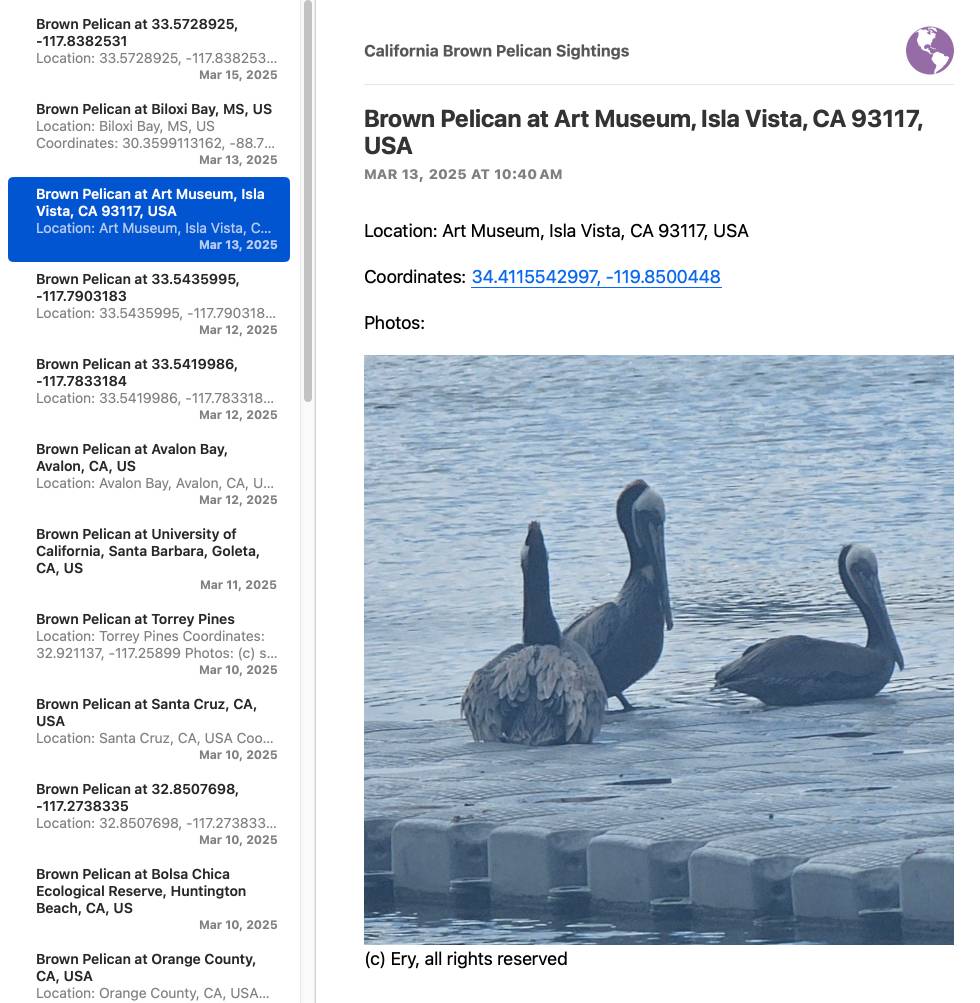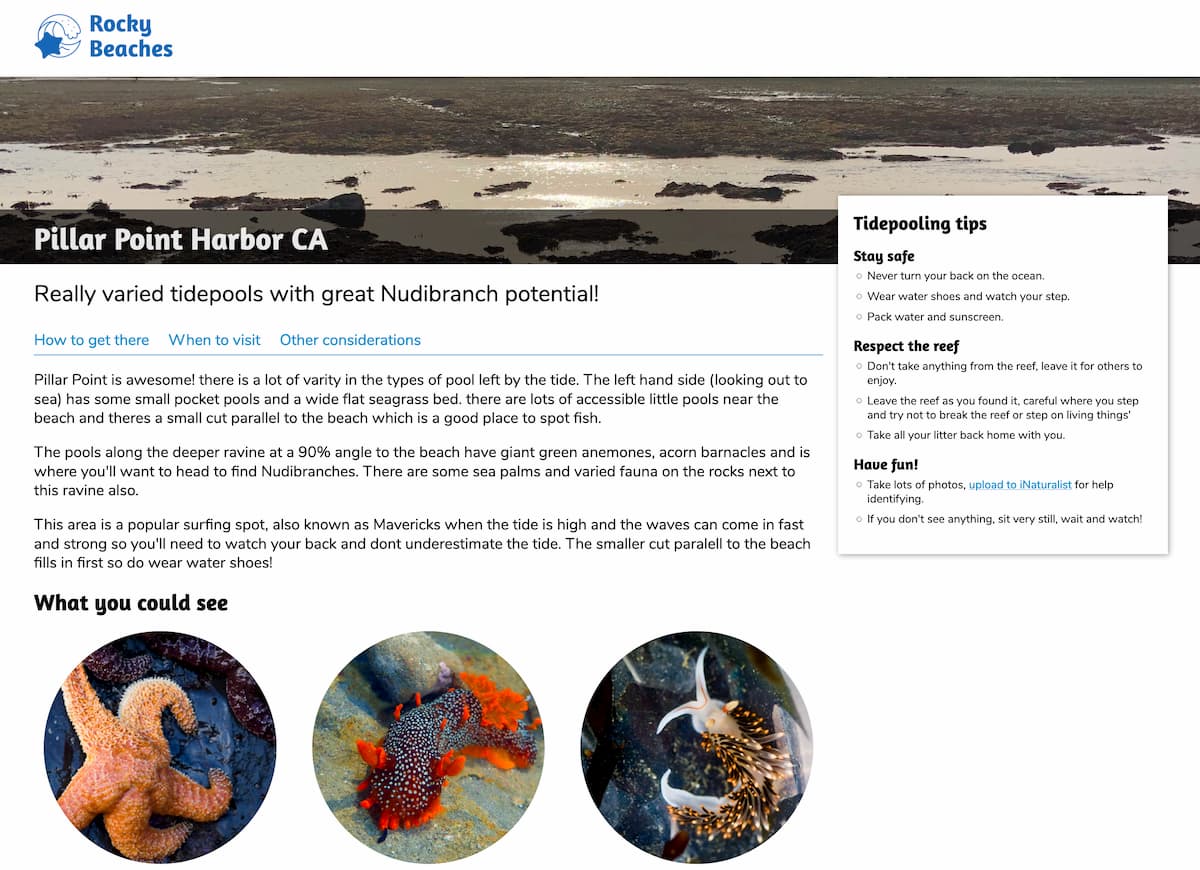8 posts tagged “inaturalist”
2025
Building and deploying a custom site using GitHub Actions and GitHub Pages. I figured out a minimal example of how to use GitHub Actions to run custom scripts to build a website and then publish that static site to GitHub Pages. I turned the example into a template repository, which should make getting started for a new project extremely quick.
I've needed this for various projects over the years, but today I finally put these notes together while setting up a system for scraping the iNaturalist API for recent sightings of the California Brown Pelican and converting those into an Atom feed that I can subscribe to in NetNewsWire:

I got Claude to write me the script that converts the scraped JSON to atom.
Update: I just found out iNaturalist have their own atom feeds! Here's their own feed of recent Pelican observations.
2020
Weeknotes: Rocky Beaches, Datasette 0.48, a commit history of my database
This week I helped Natalie launch Rocky Beaches, shipped Datasette 0.48 and several releases of datasette-graphql, upgraded the CSRF protection for datasette-upload-csvs and figured out how to get a commit log of changes to my blog by backing up its database to a GitHub repository.
2019
Practical Deep Learning for Coders 2019 (via) The deep learning evening course I took a few months ago has now been shared online in full, and it’s outstanding. “After the first lesson you’ll be able to train a state-of-the-art image classification model on your own data”—can confirm: after just the first lesson I built a bobcat v.s. cougar classifier using photos from iNaturalist.
The biggest thing I learned from the course is how powerful transfer learning is. I used to think you needed a huge amount of data to get good results from deep learning. That’s no longer true: you can take an existing model (eg ResNet for image classification) and train on top of it.
ResNet can classify images as 1,000 classes (house, cat, etc)—training an extra few hundred images of e.g. Bobcats vs Cougars only takes a couple of minutes on a GPU and can give you crazily accurate results.
It works because the pre-trained model can already pick up really subtle details—fur patterns, ear shapes etc—so you only need to train a few more layers on it for it to be able to classify against the patterns in your new set of training images.
And this doesnt just work for image classification! Natural language processing benefits from transfer learning too: take an existing model trained on the entire corpus of Wikipedia (so it knows patterns from sentence structures) and you can build IMDB sentiment analysis on top. That’s in lesson 4.
2018
Develop Your Naturalist Superpowers with Observable Notebooks and iNaturalist (via) Natalie’s article for this year’s 24 ways advent calendar shows how you can use Observable notebooks to quickly build interactive visualizations against web APIs. She uses the iNaturalist API to show species of Nudibranchs that you might see in a given month, plus a Vega-powered graph of sightings over the course of the year. This really inspired me to think harder about how I can use Observable to solve some of my API debugging needs, and I’ve already spun up a couple of private Notebooks to exercise new APIs that I’m building at work. It’s a huge productivity boost.
Automatically playing science communication games with transfer learning and fastai
This weekend was the 9th annual Science Hack Day San Francisco, which was also the 100th Science Hack Day held worldwide.
[... 1,174 words]owlsnearme source code on GitHub. Here’s the source code for our new owlsnearme.com project. It’s a single-page React application that pulls all of its data from the iNaturalist API. We built it this weekend with the SuperbOwl kick-off as a hard deadline so it’s not the most beautiful React code, but it’s a nice demonstration of how React (and create-react-app in particular) can be used for rapid development.
Owls Near Me. Back in 2010 Natalie and I shipped owlsnearyou.com—a website for finding your nearest owls, using data from the sadly deceased WildlifeNearYou (RIP). To celebrate #SuperbOwl Sunday we rebuilt the same concept on top of the excellent iNaturalist API. Search for a place to see which owls have been spotted there, or click the magic button to geolocate your device and see which owls have been spotted in your nearby area!
6M observations total! Where has iNaturalist grown in 80 days with 1 million new observations? Citizen science app iNaturalist is seeing explosive growth at the moment—they’ve been around for nearly a decade but 1/6 of the observations posted to the site were added in just the past few months. Having tried the latest version of their iPhone app it’s easy to see why: snap a photo of some nature and upload it to the app and it will use surprisingly effective machine learning to suggest the genus or even the individual species. Submit the observation and within a few minutes other iNaturalist community members will confirm the identification or suggest a correction. It’s brilliantly well executed and an utter delight to use.
